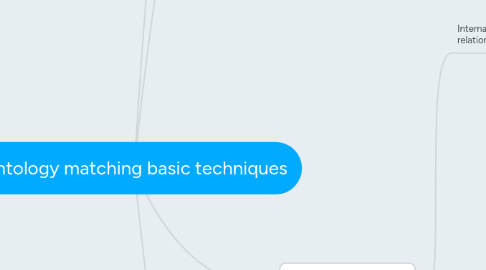
1. Measures
1.1. similarity
1.2. dissimilarity
1.3. distance
2. Name-based techniques
2.1. String-based methods: compare strings based on its structure
2.1.1. String equality
2.1.1.1. Hamming distance, counts the number of positions in which the two strings differ
2.1.2. Substring
2.1.2.1. n-gram similarity, computes the number of common sequence of n characters
2.1.3. Edit distance, minimal cost of operations to be applied to one in order to obtain the other
2.1.3.1. Levenshetein distance, minimum number of insertions, deletions, and substitutions
2.1.3.2. Needleman-Wunch distance, same as previous but with ins and del costs higher
2.1.3.3. Monge-Elkam distance function
2.1.3.4. Jaro measure, it is based on the number and proximity of the common characters between two strings
2.1.3.5. Jaro-Winkler mesaure, gives more favourable ratings to strings that match from the beginning for a set prefix length
2.1.4. Token-based distance
2.1.4.1. Cosine similarity
2.1.4.2. Term frequency-Inverse document frequency
2.1.5. Path distance, compare the sequence of labels of entities to which those bearing the label are related
2.1.6. Frameworks
2.1.6.1. SecondString, http://secondstring.sourceforge.net/
2.1.6.2. Alignment API, http://alignapi.gforge.inria.fr/
2.1.6.3. SimPack, https://files.ifi.uzh.ch/ddis/oldweb/ddis/research/simpack/index.html
2.2. Language-based methods
3. Structured-based techniques
3.1. Internal structure (properties, their attributes, their relations) etc...
3.1.1. Property comparison and keys
3.1.2. Datatype comparison
3.1.2.1. the proximity between datatypes should be maximal when these are the same types, lower when they are compatible and the lowest when they are non compatible
3.1.2.2. these methods cannot be used in isolation
3.1.3. Domain comparison
3.1.3.1. Relative size distance, the distance between two domains is then given by the difference between their size and that of their common generalisation
3.1.4. Cardinality comparison
3.1.4.1. Multiplicity similarity, two multiplicities are compatible if the intersection of the corresponding intervals is non empty
3.2. Relation structure, exploiting relations in an ontology
3.2.1. comparing the entities in direct relation
3.2.2. comparing the entities in the transitive reduction of relation r
3.2.3. comparing the entities in the transitive clousure of relation r
3.2.4. comparing the entitties coming through a relation r
3.2.5. comparing the entities which are ultimately in r+ (maximal elements)
3.2.6. taxonomic structure
3.2.6.1. count the number of edges in the taxonomy between two classes
3.2.6.2. Wu-Palmer similarity, two classes near the root of hierarchy are close to each other in terms of edges but can be very different conceptually
3.2.6.3. Upward cotopic similarity, applies the Jaccard similarity to cotopies
3.2.6.4. comparing taxonomies: semantic cotopy (SC), all its super and subconcepts. taxonomic overloap --> The taxonomic overlap (TO) between H1 and H2 as seen from the concepts referred to by L may then be computed by following F−11 and F−12 back to the common lexicon
3.2.7. relations
3.2.7.1. If we have a set of relations in the first ontology which is similar to another set of relations in the second ontology, it is possible that two classes, which are the domains of relations in those two sets, are similar too
3.2.8. comparing relations: relation overloap --> geometric mean value of how similar their domain and range concepts are
